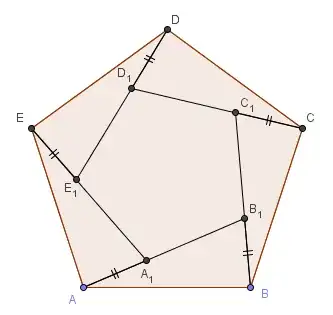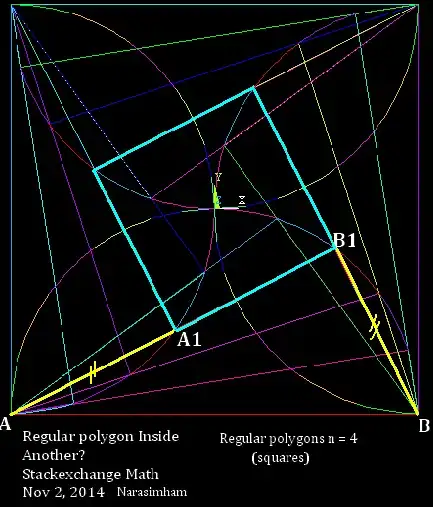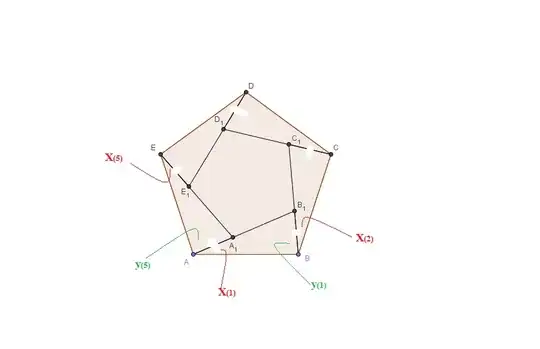Update
Won't include the trig as rather lengthy, but included as visual complement to give genreal idea:

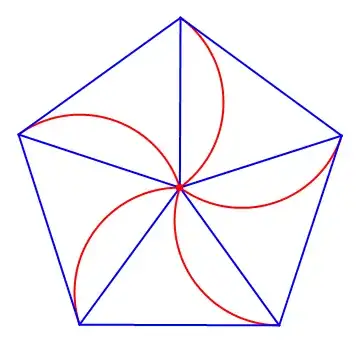
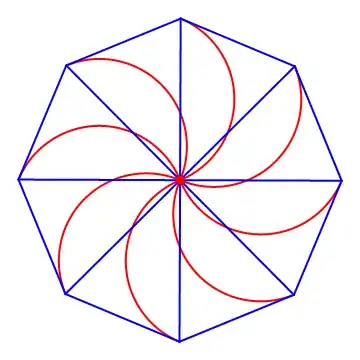

Note that a shutter on a traditional camera works on this same principal:
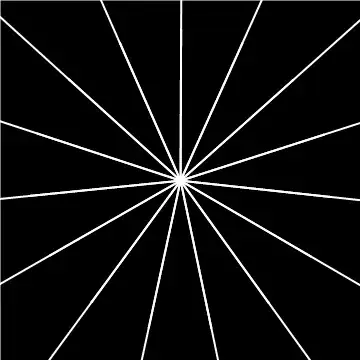
Note also that Narasimham's observation of the paths taken offer visual proof of the conjecture, and for greater $n$, are quite visually compelling:

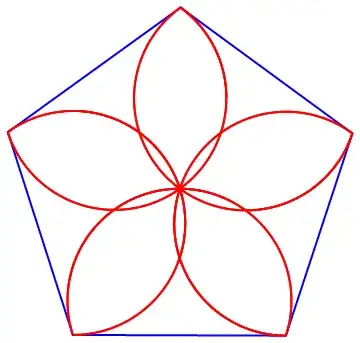

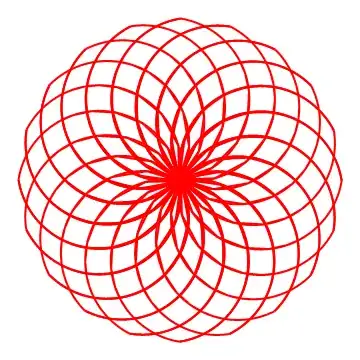
Code at Narasimham's request:
Manipulate[
Show[\[Theta] = LambertW[1]//N; length = -10; g = 0.2;
tt = {1.337, 1.236, 1.18, 1.144, 1.121, 1.104, 1.091, 1.081, 1.073,
1.066, 1.061, 1.056, 1.052, 1.049, 1.046, 1.043, 1.041, 1.039};
r = c*(rr =
If[n < 2*Pi,
Pi + n*(-1 + 2*Pi) +
n*ArcTan[
Cos[1] + Cos[1 - (4*Pi)/n] + 2*Cos[1 - (2*Pi)/n] -
2*Sqrt[2]*
Sqrt[(3 + Cos[(2*Pi)/n])*Sin[Pi/n]^2*Sin[1 - (2*Pi)/n]^2],
4*Cos[Pi/n]^2*Sin[1 - (2*Pi)/n] +
2*Sqrt[2]*Cot[1 - (2*Pi)/n]*
Sqrt[(3 + Cos[(2*Pi)/n])*Sin[Pi/n]^2*
Sin[1 - (2*Pi)/n]^2]],
Pi + n*(-1 + 2*Pi) +
n*ArcTan[
Cos[1] + Cos[1 - (4*Pi)/n] + 2*Cos[1 - (2*Pi)/n] +
2*Sqrt[2]*
Sqrt[(3 + Cos[(2*Pi)/n])*Sin[Pi/n]^2*Sin[1 - (2*Pi)/n]^2],
4*Cos[Pi/n]^2*Sin[1 - (2*Pi)/n] -
2*Sqrt[2]*Cot[1 - (2*Pi)/n]*
Sqrt[(3 + Cos[(2*Pi)/n])*Sin[Pi/n]^2*
Sin[1 - (2*Pi)/n]^2]]]);
aa = Table[{Cos[1 + (2*k*Pi)/n]*Cos[\[Theta]] -
Sin[1 + (2*k*Pi)/n]*Sin[\[Theta]],
Cos[\[Theta]]*Sin[1 + (2*k*Pi)/n] +
Cos[1 + (2*k*Pi)/n]*Sin[\[Theta]]}, {k, Join[{n}, Range[n]]}];
li = Table[{(2*
Sin[r/n]*(-Sin[1 + ((2*s + 1)*Pi)/n + \[Theta]] +
Cos[Pi/n]*Sin[(n + (2*s + 1)*Pi + r + n*\[Theta])/n]))/(3 +
Cos[Pi/n]^2 - 4*Cos[Pi/n]*Cos[r/n] -
Sin[Pi/n]^2), (2*(Cos[1 + ((2*s + 1)*Pi)/n + \[Theta]] -
Cos[Pi/n]*Cos[(n + (2*s + 1)*Pi + r + n*\[Theta])/n])*
Sin[r/n])/(3 + Cos[Pi/n]^2 - 4*Cos[Pi/n]*Cos[r/n] -
Sin[Pi/n]^2)}, {s, 1, n}];
list = Join[Drop[li, n - 2], Take[li, n - 2]];
Graphics[{Opacity[If[TrueQ[JamesBond] == True, 1, 0]], Black,
Polygon[{{-(1 + g), -(1 + g)}, {1 + g, -(1 + g)}, {1 + g,
1 + g}, {-(1 + g), 1 + g}}], {Red, Thick,
Opacity[If[TrueQ[JamesBond] == True, 0,
If[TrueQ[circles] == True, 1, 0]]], Circle[]}, {Red, Thick,
Opacity[If[TrueQ[JamesBond] == True, 0,
If[TrueQ[circles] == True, 1, 0]]], Circle[{0, 0}, Cos[Pi/n]]},
Opacity[If[TrueQ[JamesBond] == True, 0, 1]], Thick, Blue,
Line[aa], Opacity[If[TrueQ[JamesBond] == True, 1, 0]], White,
Polygon[list], Opacity[1],
If[TrueQ[JamesBond] == True, White, Blue], Thick,
bb = Table[Line[{aa[[u]], list[[u]]}], {u, 1, n}],
Opacity[If[TrueQ[JamesBond] == True, 0, 1]], Red,
PointSize[Large], Point[list],
If[TrueQ[JamesBond] == True, White, Red],
Opacity[If[TrueQ[JamesBond] == True, 1,
If[TrueQ[lines] == True, 1, 0]]],
Table[Line[{bb[[u, 1,
1]], {bb[[u, 1, 2,
1]] + ((bb[[u, 1, 2, 1]] - bb[[u, 1, 1, 1]])*length)/
Sqrt[Abs[(bb[[u, 1, 1, 1]] -
bb[[u, 1, 1, 2]])*2 + (bb[[u, 1, 1, 2]] -
bb[[u, 1, 2, 2]])*2]],
bb[[u, 1, 2,
2]] + ((bb[[u, 1, 2, 2]] - bb[[u, 1, 1, 2]])*length)/
Sqrt[Abs[(bb[[u, 1, 1, 1]] -
bb[[u, 1, 1, 2]])*2 + (bb[[u, 1, 1, 2]] -
bb[[u, 1, 2, 2]])*2]]}}], {u, 1, n}]}],
PlotRange -> {{-(1 + g), 1 + g}, {-(1 + g), 1 + g}}], {{c,
If[TrueQ[min] == True, 1.18, 1]},
If[TrueQ[min] == True, Evaluate[tt[[n - 2]]], 1],
Dynamic[
1*n*(Pi/If[n < 2*Pi,
Pi + n*(-1 + 2*Pi) +
n*ArcTan[
Cos[1] + Cos[1 - (4*Pi)/n] + 2*Cos[1 - (2*Pi)/n] -
2*Sqrt[2]*
Sqrt[(3 + Cos[(2*Pi)/n])*Sin[Pi/n]^2*Sin[1 - (2*Pi)/n]^2],
4*Cos[Pi/n]^2*Sin[1 - (2*Pi)/n] +
2*Sqrt[2]*Cot[1 - (2*Pi)/n]*
Sqrt[(3 + Cos[(2*Pi)/n])*Sin[Pi/n]^2*
Sin[1 - (2*Pi)/n]^2]],
Pi + n*(-1 + 2*Pi) +
n*ArcTan[
Cos[1] + Cos[1 - (4*Pi)/n] + 2*Cos[1 - (2*Pi)/n] +
2*Sqrt[2]*
Sqrt[(3 + Cos[(2*Pi)/n])*Sin[Pi/n]^2*Sin[1 - (2*Pi)/n]^2],
4*Cos[Pi/n]^2*Sin[1 - (2*Pi)/n] -
2*Sqrt[2]*Cot[1 - (2*Pi)/n]*
Sqrt[(3 + Cos[(2*Pi)/n])*Sin[Pi/n]^2*
Sin[1 - (2*Pi)/n]^2]]])]}, {{n, 5}, 3, 20,
1}, {{circles, False}, {True, False}}, {{lines, False}, {True,
False}}, {{JamesBond, False}, {True, False}}, {{min, False}, {True, False}}]
paths calculated separately with
n = 10;
Show[\[Theta] = LambertW[1]//N;
aa = Table[{Cos[1 + (2 k \[Pi])/n] Cos[\[Theta]] -
Sin[1 + (2 k \[Pi])/n] Sin[\[Theta]],
Cos[\[Theta]] Sin[1 + (2 k \[Pi])/n] +
Cos[1 + (2 k \[Pi])/n] Sin[\[Theta]]}, {k, Join[{n}, Range[n]]}];
Graphics[{Thick, Blue, Line[aa]}], Show[\[Theta] = LambertW[1];
Graphics[Thick, Blue, Line[aa]],
r = c*(Pi + 20*(-1 + 2*Pi) +
20*ArcTan[(4*Cos[Pi/20]^2*Sin[1 - Pi/10] -
2*Sqrt[2*(3 + Sqrt[5/8 + Sqrt[5]/8])]*Cos[1 - Pi/10]*
Sin[Pi/20])/(Cos[1] + Cos[1 - Pi/5] + 2*Cos[1 - Pi/10] +
2*Sqrt[2*(3 + Sqrt[5/8 + Sqrt[5]/8])]*Sin[1 - Pi/10]*
Sin[Pi/20])]);
Table[ParametricPlot[\[Theta] = LambertW[1]//N; {(
2 Sin[r/n] (-Sin[1 + ((2 s + 1) \[Pi])/n + \[Theta]] +
Cos[\[Pi]/n] Sin[(n + (2 s + 1) \[Pi] + r + n \[Theta])/n]))/(
3 + Cos[\[Pi]/n]^2 - 4 Cos[\[Pi]/n] Cos[r/n] - Sin[\[Pi]/n]^2), (
2 (Cos[1 + ((2 s + 1) \[Pi])/n + \[Theta]] -
Cos[\[Pi]/n] Cos[(n + (2 s + 1) \[Pi] + r + n \[Theta])/
n]) Sin[r/n])/(
3 + Cos[\[Pi]/n]^2 - 4 Cos[\[Pi]/n] Cos[r/n] -
Sin[\[Pi]/n]^2)}, {c, 0, 0.5}, Axes -> False, PlotRange -> All,
PlotStyle -> {Red, Thick}], {s, 1, n}]]]
just change n as desired.
Original answer
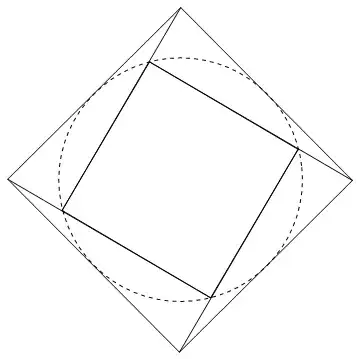
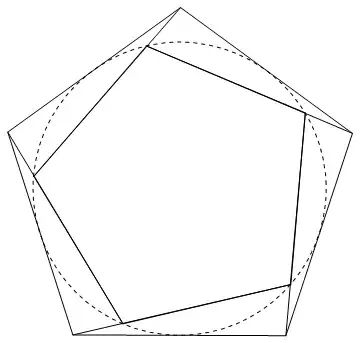
Idea
Since all regular polygons can be inscribed in the unit circle, a circle can then be inscribed in the polygon (dashed) and a further polygon inside that. If lines then join the vertices of the outer polygon to the corresponding ones of the inner polygon, the outer polygon can be fixed while the inner is rotated. The adjoining lines will then form a third polygon that decreases in size to $0$ when the inner polygon is rotated a half turn. Since the outer is fixed, the relation follows.
Details
A polygon inscribed in a unit circle has vertices at $$e^{i(1 + 2\pi k/n)}$$ for all $k=1$ to $n$, where $n$ is the number of sides of the polygon. This can be described in cartesian coordinates as $$\{\Re\ e^{i(1 + 2\pi k/n)},\Im\ e^{i(1 + 2\pi k/n)}\}.$$ The polygon can then be rotated about the origin so that the uppermost vertex lies on the $y$-axis by multiplying by matrix
\begin{pmatrix}
\Re \ e^{i\Omega} & -\Im \ e^{i\Omega}\\
\Im \ e^{i\Omega}& \Re \ e^{i\Omega}\\
\end{pmatrix}
where $\Omega$ is the Omega constant.
A smaller circle, with radius $\Re \ e^{i\pi/n}$, where $n$ is the number of sides of the polygon, can then be inscribed inside it.
The polygon to be inscribed and rotated within that will then have coordinates
\begin{align}
\Re \ e^{i\pi/n}
\begin{pmatrix}
\Re \ e^{i\Omega_{1}} & -\Im \ e^{i\Omega_{1}}\\
\Im \ e^{i\Omega_{1}}& \Re \ e^{i\Omega_{1}}\\
\end{pmatrix}
\cdot \{\Re\ e^{i(1 + 2\pi k/n)},\Im\ e^{i(1 + 2\pi k/n)}\}
\end{align}
where $\Omega_{1}=\dfrac{r}{n}+\Omega$, with $r$ ranging from $0$ to $n\pi.$
Mathematica code to play with:
Manipulate[ Show[\[Theta] = LambertW[1] // N;
c = Re[E^( I Pi/n)]; \[CapitalTheta] = r/n + \[Theta];
Graphics[{(*Circle[]*){Circle[{0, 0}, c]},
Line[aa = (Table[{{Re[E^( I \[Theta])], -Im[E^( I \[Theta])]},
{Im[E^( I \[Theta])], Re[E^( I \[Theta])]}}.{Re[ E^(I (1 + 2 \[Pi] k/n))],
Im[E^(I (1 + 2 \[Pi] k/n))]}, {k, Join[{n}, Range[n]]}])],
Line[bb = (c Table[{{Re[E^( I \[CapitalTheta])], -Im[E^( I \[CapitalTheta])]},
{Im[E^( I \[CapitalTheta])],
Re[E^( I \[CapitalTheta])]}}.{ Re[E^(I ( 1 + 2 \[Pi] k/n))],
Im[E^(I ( 1 + 2 \[Pi] k/n))]}, {k,Join[{n}, Range[n]]}])],
Line[Table[{aa[[q]], bb[[q]]}, {q, 1, n}]] }], Axes -> False,
PlotRange -> {{-1, 1}, {-1, 1}}], {{r, 0}, 0, n Pi}, {{n, 3}, 3, 20, 1}]
